Fleurs du Mal Magazine


Or see the index
.jpg)
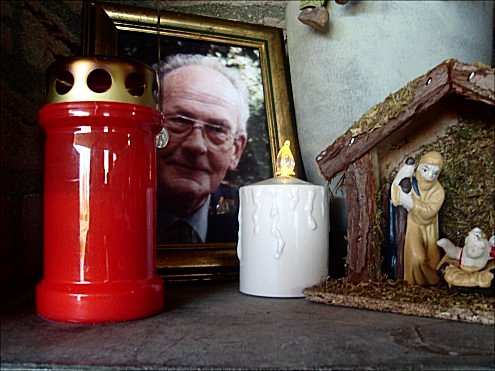
.jpg)
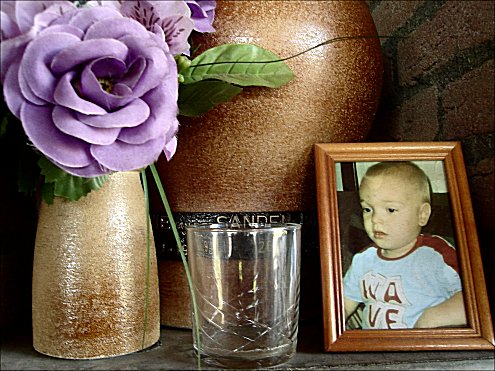
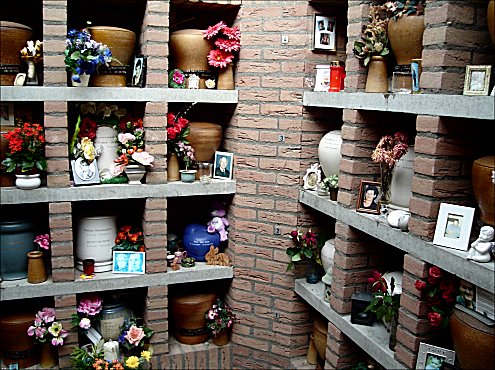
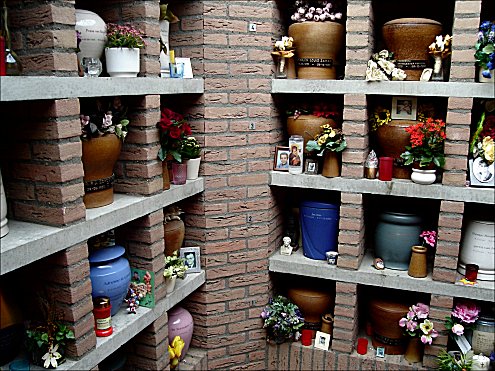
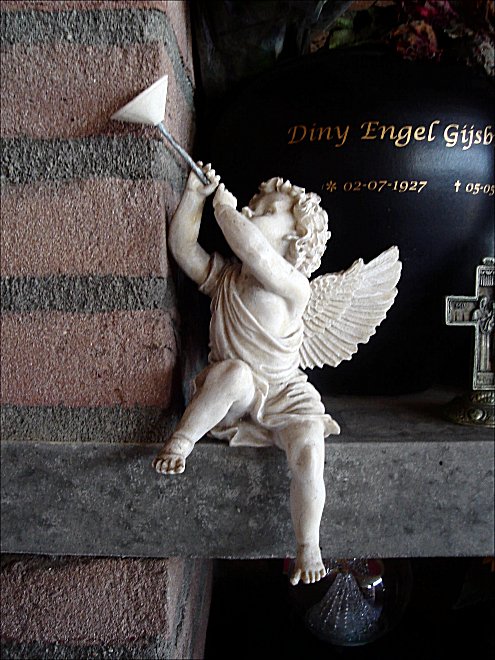
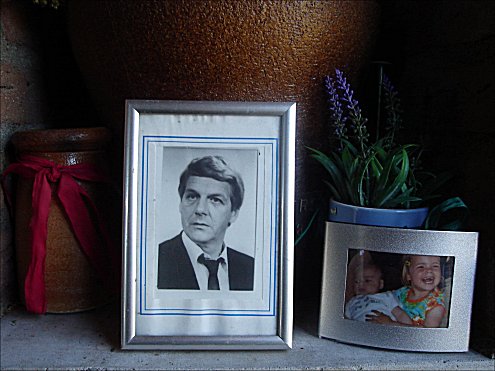
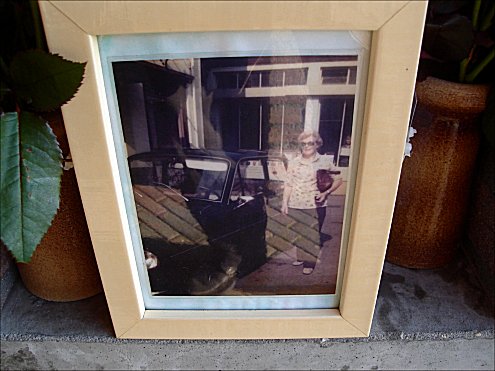
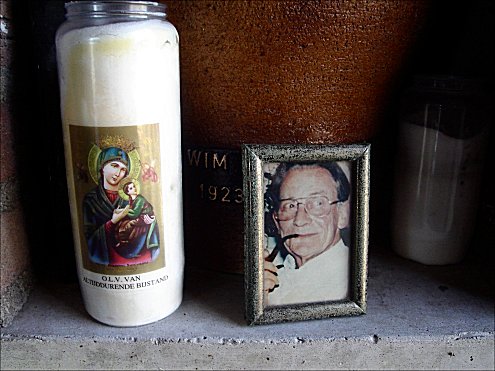
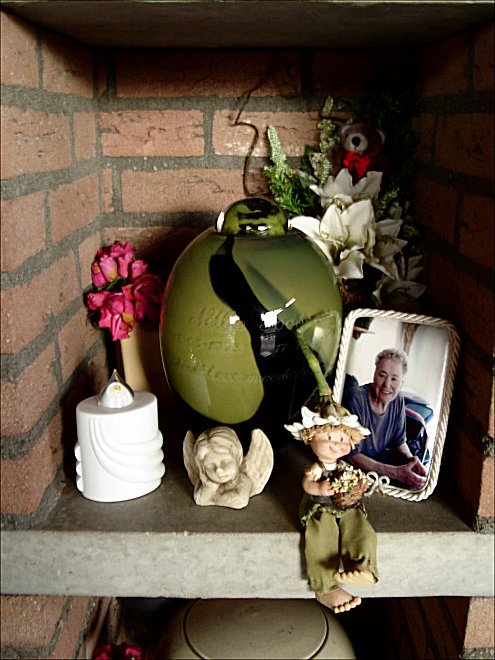
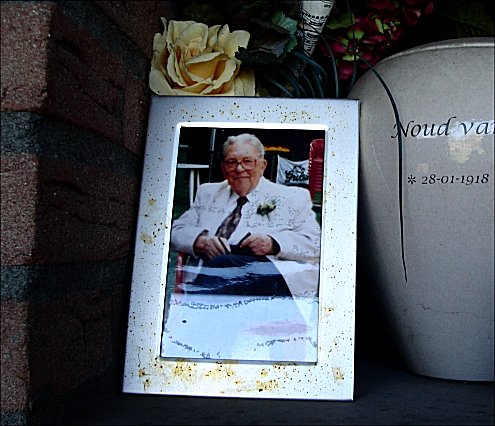
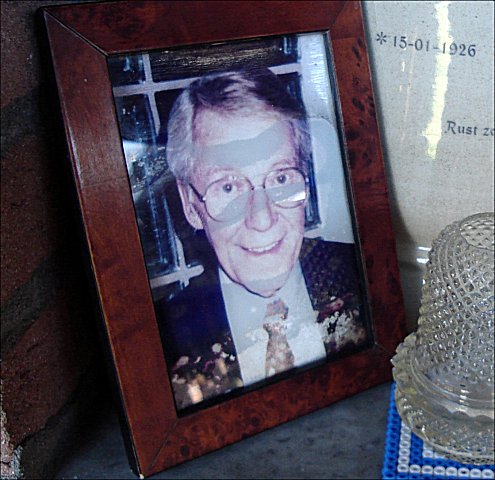
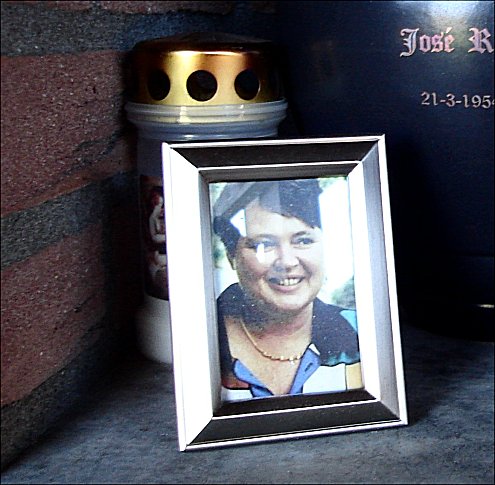
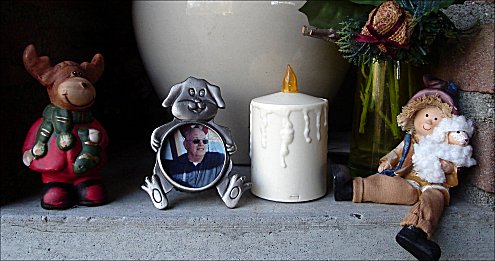
Galerie des Morts IX
Tilburg-West NL
Photos Kempis
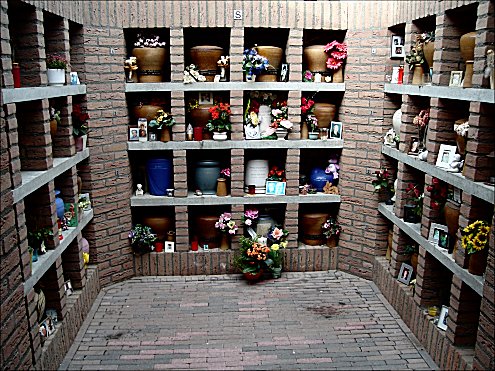
KEMP=MAG poetry magazine – magazine for art & literature
More in: Galerie des Morts
.jpg)
B A U E R N I N B E R L I N
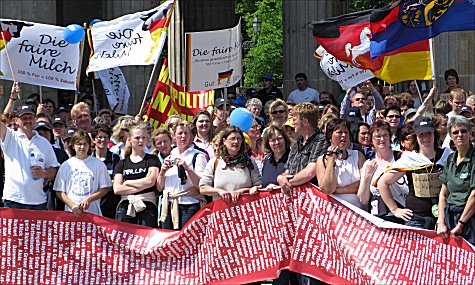
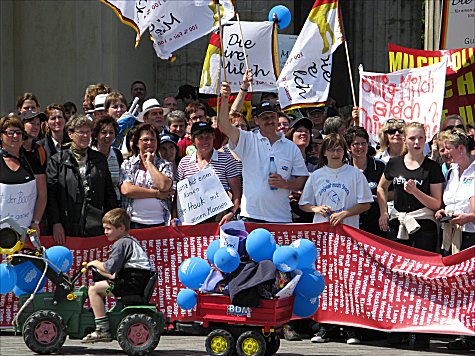
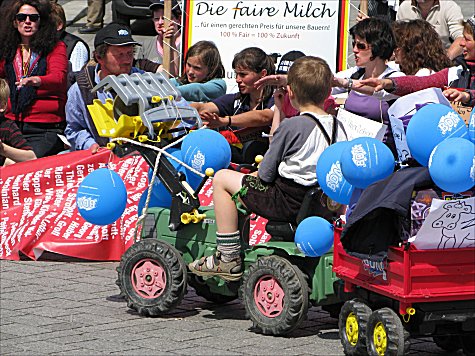
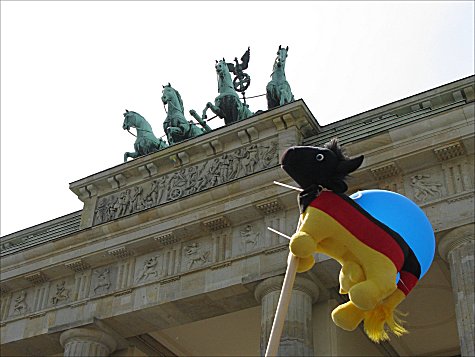

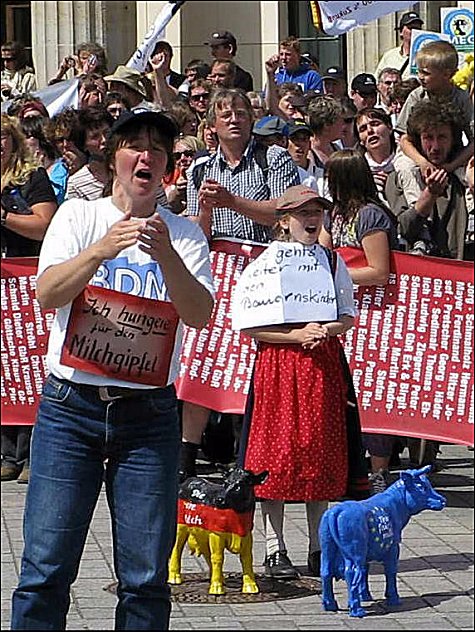
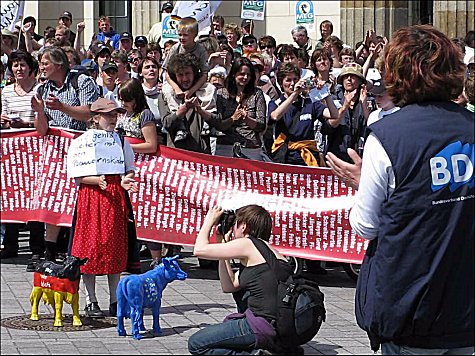

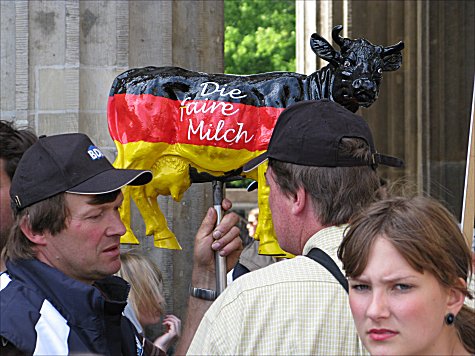
Nachrichten aus Berlin – Anton K. Berichtet:
Bauern in Berlin – Mai 2009
Am Brandenburger Tor fand die Abschlusskundgebung statt der Milchbäuerinnen des Bundesverbands Deutscher Milchviehhalter (BDM). Sie protestierten gegen die ungefähr 25 Eurocent die Sie jetzt pro Liter Milch empfangen und fordern ein Minimum von 40 Cent. Ihren Hungerstreik vor dem Berliner Kanzleramt um mit Angela Merkel über dieses Thema diskutieren zu können, hatte nicht das gewünschte resultat.
Museum of public protest
![]()
fleursdumal.nl magazine – magazine for art & literature
More in: MUSEUM OF PUBLIC PROTEST, Nachrichten aus Berlin

RICHARD LONG
HEAVEN AND EARTH
Tate Britain London
3 June – 6 September 2009
Heaven and Earth is a major exhibition of the work of Richard Long and his first survey in London for eighteen years. The exhibition will include important works selected across four decades and will provide an opportunity to understand afresh Long’s radical rethinking of the relationship between art and landscape. Comprising around 80 works, Heaven and Earth will include sculptures, new large-scale wall works, and photographic and text works documenting walks around the world, from Dartmoor to Japan.
Richard Long first came to prominence in the late 1960s and is part of a generation of British artists who extended the possibilities of sculpture beyond traditional materials and methods. Long’s work is rooted in his deep affinity with nature, developed during solitary walks. Long revolutionised the definition of sculpture by using walking as a medium. These walks take him through rural areas in Britain, or as far a field as the plains of Canada, Mongolia and Bolivia. Long never makes significant alterations to the landscapes he passes through. Instead he adjusts the natural order of wilderness places, up-ending stones for example, or making simple, geometric shapes. His work explores relationships between time, distance, geography, measurement and movement.
Heaven and Earth will reflect the distinctive themes and interests in his work; sculptures of stones, watery mud works, and photographic and text works which record walks in global locations, or from a local area of life-long interest like Dartmoor. Long presents his work in various forms, which include artists’ books and postcards, all of which are ascribed equal value. The exhibition will include key early works such as A Line Made by Walking, England 1967, made in a field where the artist walked back and forth until the flattened grass caught by the sunlight became visible as a line, a path going ‘nowhere’. Long then photographed this work, as he has continued to record similar works in the landscape.
Mostly working in the landscape, Richard Long sometimes brings materials into the gallery. Four of Long’s dramatic mud works, which represent the forces of speed, water, chance and gravity will be made directly on to the walls for the show. The large central gallery of the exhibition will be devoted to six major stone sculptures. Norfolk Flint Circle 1990 is an eight metre sculpture consisting of a single layer of flints lying close together on the floor. In the gallery, as on his walks, Long lays the stones in simple geometric configurations such as circles, lines, and ellipses. The exhibition will also include early examples of remote stone sculptures such as the first stone circle made while walking in the Andes in 1972.
Richard Long was born in Bristol in 1945 where he continues to live and work. Long has exhibited widely since his first solo show at the Konrad Fischer Gallery in Düsseldorf in 1968. He represented Britain in the British Pavilion at the Venice Biennale in 1976 and was awarded the Turner Prize in 1989. In 1990 he became a Chevalier dans l’Ordre des Arts et des Lettres. Heaven and Earth is curated by Clarrie Wallis, Curator of Contemporary Art, Tate Britain, assisted by Helen Little, Assistant Curator, Tate Britain. A fully illustrated publication produced by Tate Publishing will accompany the exhibition and will include previously unseen works.
Tate Britain London
3 June – 6 September 2009
• fleursdumal.nl magazine
More in: Art & Literature News, Exhibition Archive, FDM Art Gallery, Richard Long, Sculpture
.jpg)
– Demonstration Deutsche Gewerkschaftsbund –

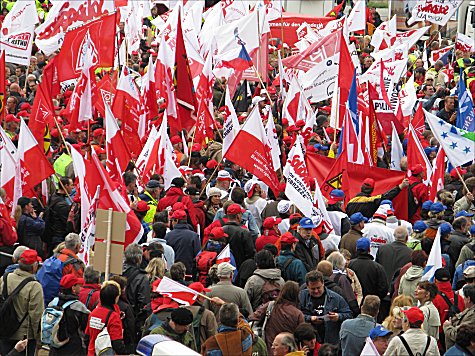

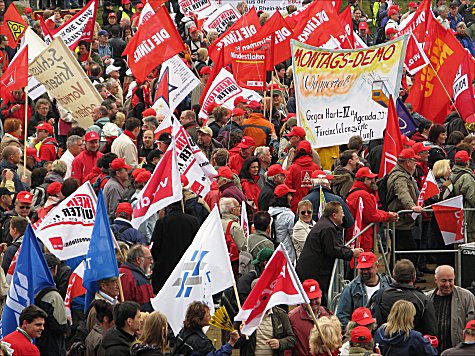




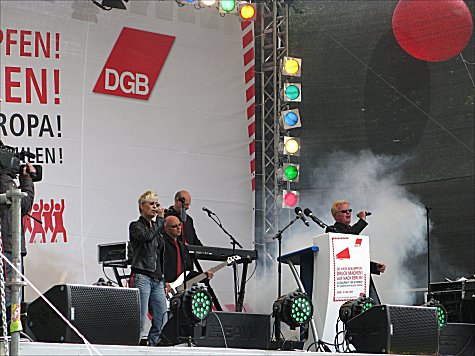
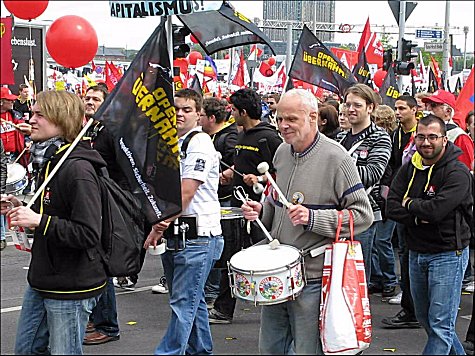
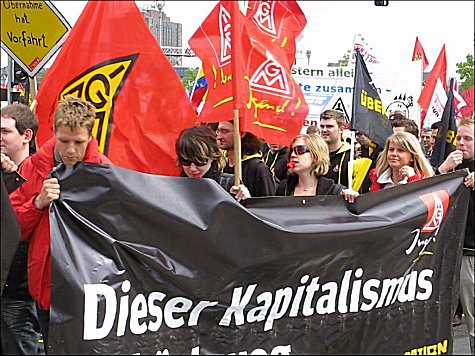
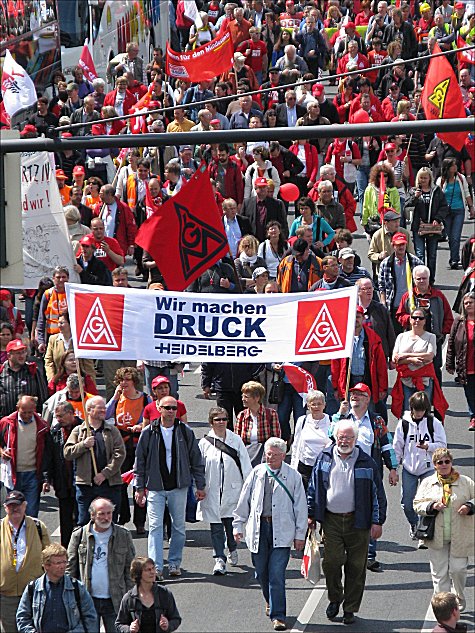
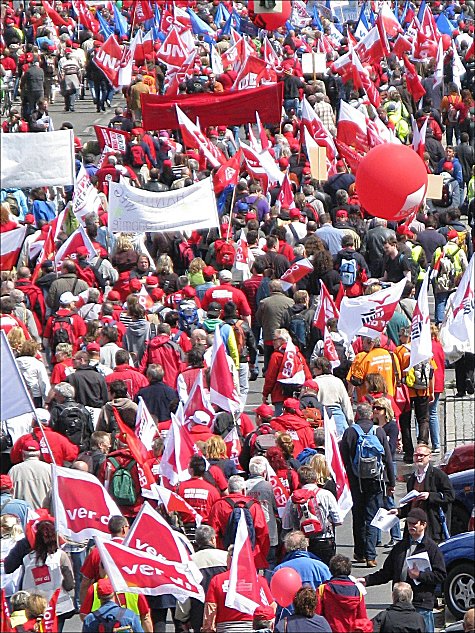

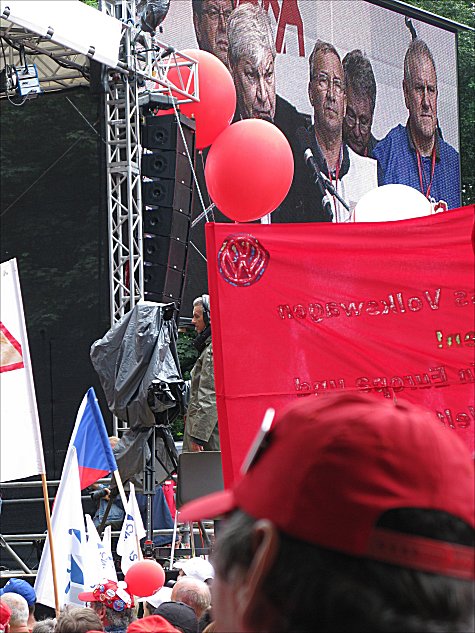
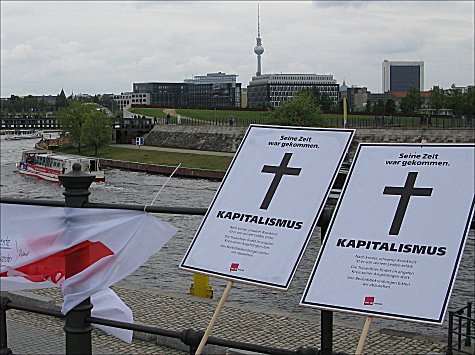
Nachrichten aus Berlin
Unser Korrespondent Anton K. berichtet
Demonstration Deutsche Gewerkschaftsbund
Am 16 Mai 2009 gab es eine große demonstration organisiert vom Deutsche Gewerkschaftsbund unter dem Thema “Die Kriese bekämpfen. Sozialpakket fur Europa. Die Verursacher müssen zahlen.. ” Von Treffpunkte Breidscheidplatz und Hauptbahnhof zogen etwa 100.000 Teilnehmer durch Berlin zu der Hauptkundgebung zwischen S-Bahnhof Tiergarten und Sieggessäule. Redner waren unter anderen Michael Sommer, Vorsitzender des DGB und John Monks (Generalsekretär des Europäischen Gewerkschaftsbundes).
![]()
fleursdumal.nl magazine – museum of public protest
More in: FDM in Berlin, Galerie Deutschland, MUSEUM OF PUBLIC PROTEST, Nachrichten aus Berlin
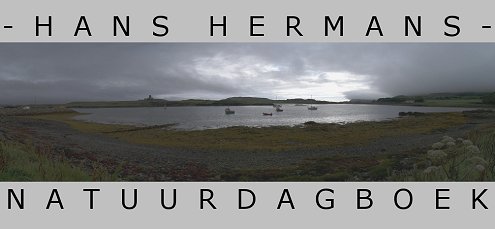
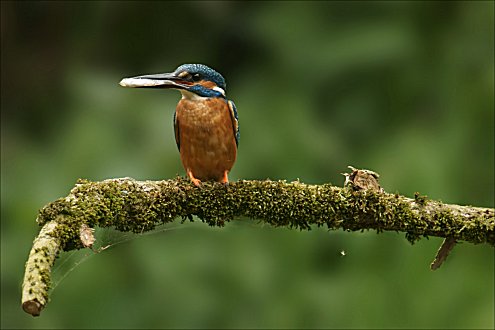
W i l l i a m B l a k e
(1757-1827)
Seven poems from: Songs of Innocence
& Songs of Experience
Introduction
Hear the voice of the Bard,
Who present, past, and future, sees;
Whose ears have heard
The Holy Word
That walked among the ancient trees;
Calling the lapsed soul,
And weeping in the evening dew;
That might control
The starry pole,
And fallen, fallen light renew!
‘O Earth, O Earth, return!
Arise from out the dewy grass!
Night is worn,
And the morn
Rises from the slumbrous mass.
‘Turn away no more;
Why wilt thou turn away?
The starry floor,
The watery shore,
Is given thee till the break of day.’
The Blossom
Merry, merry sparrow!
Under leaves so green
A happy blossom
Sees you, swift as arrow,
Seek your cradle narrow,
Near my bosom.
Pretty, pretty robin!
Under leaves so green
A happy blossom
Hears you sobbing, sobbing,
Pretty, pretty robin,
Near my bosom.

Spring
Sound the flute!
Now it’s mute!
Birds delight,
Day and night,
Nightingale,
In the dale,
Lark in sky, –
Merrily,
Merrily, merrily to welcome in the year.
Little boy,
Full of joy;
Little girl,
Sweet and small;
Cock does crow,
So do you;
Merry voice,
Infant noise;
Merrily, merrily to welcome in the year.
Little lamb,
Here I am;
Come and lick
My white neck;
Let me pull
Your soft wool;
Let me kiss
Your soft face;
Merrily, merrily we welcome in the year.
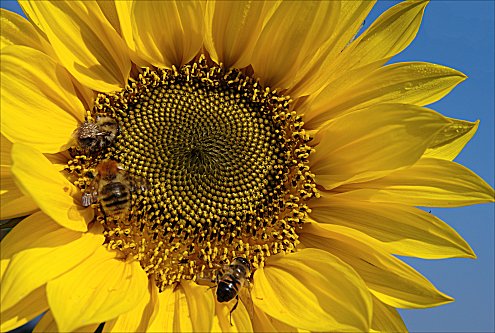
Ah, Sunflower
Ah, sunflower, weary of time,
Who countest the steps of the sun;
Seeking after that sweet golden clime
Where the traveller’s journey is done;
Where the Youth pined away with desire,
And the pale virgin shrouded in snow,
Arise from their graves, and aspire
Where my Sunflower wishes to go!
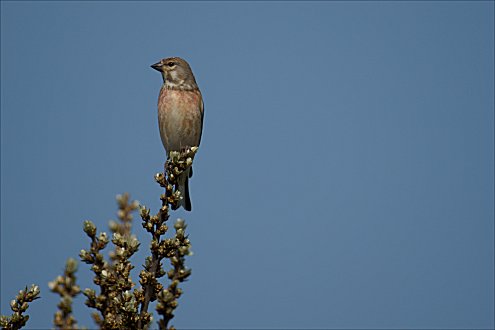
The Lily
The modest Rose puts forth a thorn,
The humble sheep a threat’ning horn:
While the Lily white shall in love delight,
Nor a thorn nor a threat stain her beauty bright.
Laughing Song
When the green woods laugh with the voice of joy,
And the dimpling stream runs laughing by;
When the air does laugh with our merry wit,
And the green hill laughs with the noise of it;
When the meadows laugh with lively green,
And the grasshopper laughs in the merry scene;
When Mary and Susan and Emily
With their sweet round mouths sing ‘Ha ha he!’
When the painted birds laugh in the shade,
Where our table with cherries and nuts is spread:
Come live, and be merry, and join with me,
To sing the sweet chorus of ‘Ha ha he!’

The Echoing Green
The sun does arise,
And make happy the skies;
The merry bells ring
To welcome the Spring;
The skylark and thrush,
The birds of the bush,
Sing louder around
To the bells’ cheerful sound;
While our sports shall be seen
On the echoing green.
Old John, with white hair,
Does laugh away care,
Sitting under the oak,
Among the old folk.
They laugh at our play,
And soon they all say,
‘Such, such were the joys
When we all–girls and boys –
In our youth-time were seen
On the echoing green.’
Till the little ones, weary,
No more can be merry:
The sun does descend,
And our sports have an end.
Round the laps of their mothers
Many sisters and brothers,
Like birds in their nest,
Are ready for rest,
And sport no more seen
On the darkening green.
Hans Hermans Natuurdagboek- May 2009
Poems: Williem Blake – Photos: Hans Hermans
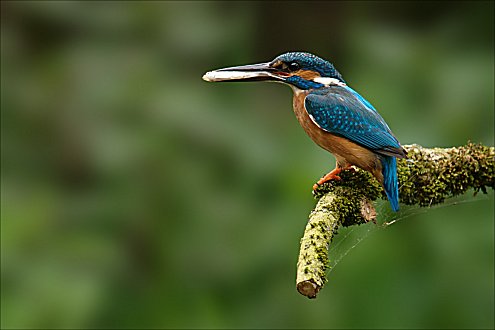
© hans hermans
KEMP=MAG poetry magazine – magazine for art & literature
More in: Blake, William, Hans Hermans Photos, MUSEUM OF NATURAL HISTORY - department of ravens & crows, birds of prey, riding a zebra, spring, summer, autumn, winter
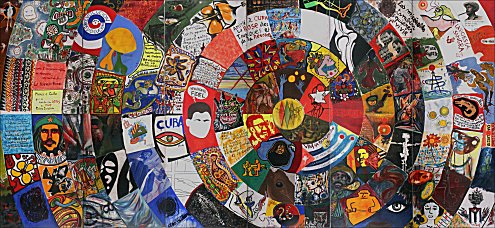
Groninger Museum
C u b a !
Kunst en geschiedenis van 1868 tot heden
17 mei tot en met 20 september 2009
Het Groninger Museum presenteert van 17 mei tot en met 20 september 2009 een grote overzichtstentoonstelling over de ontwikkeling in de kunst en de geschiedenis van Cuba van 1868 tot heden. Er worden werken getoond van ruim honderd kunstenaars, die variëren van traditioneel tot posterkunst, installaties, video en een bijzondere selectie van fotografie, zowel documentair als artistiek.
Deze tentoonstelling vertelt het verhaal van een jong land met een eeuwenoude cultuur. Cuba is een eiland waarvan de turbulente geschiedenis doortrokken is van de belangrijkste kwesties van de twintigste eeuw, waaronder de kolonisatie, het zoeken naar een nationale identiteit, onafhankelijkheidsoorlogen en nieuwe politieke onbereikbare idealen.
De eerste Cubaanse landschapsschilderingen dateren uit het begin van de koloniale tijd. In de negentiende eeuw dienden schilderingen van het platteland ter illustratie van de ontwikkeling van de opkomende suikerindustrie. In de tweede helft van de negentiende eeuw waren er veel kunstenaars actief. Vaak vertrokken ze na het afronden van hun studie in Havana naar Europa voor vervolgopleidingen. Bekende kunstenaars waren Wilfredo Lam en Esteban Chartrand, die het schilderen van landschappen tot verdere ontwikkeling brachten.
Voorlopers van de fotojournalistiek trokken rond met een kar om beelden vast te leggen van straathoeken, het platteland en belangrijke gebeurtenissen zoals branden, openluchtmissen en landverschuivingen en brachten zo een nieuwe specialiteit: de documentairefoto. Dergelijke afdrukken werden ‘Engelse kaarten’ genoemd en in Cuba werden ze algemeen bekend als “Tarjetones”; de afdruk werd op een kaartje geplakt met op de achterkant een korte beschrijving van het beeld.
Aan het begin van Cuba’s Onafhankelijkheidsoorlog in 1895, was de fotografie al goed in de kranten vertegenwoordigd. Net als de foto’s uit de Tienjarige Oorlog waren de beelden van de oorlog van 1895 geposeerd en sereen. Het waren voornamelijk portretten van individuen of van militaire groeperingen. Belangrijke fotografen uit die tijd waren de Cubaanse broers José Manuel en José María Mora en Juan Bautista Valdés en Joaquín Blez.
De jaren zeventig uit de twintigste eeuw waren een complexe, tegenstrijdige periode. Volgens het ideologische model had kunst voornamelijk een educatieve functie en jonge kunstenaars werkten in een officiële en voorgeschreven stijl. Met gevarieerde visuele middelen werd uitdrukking gegeven aan de Cubaanse identiteit, de voortgang van avant-garde bewegingen, inheemse en Afro-Cubaanse mythen, plattelandstradities en de stroming van de pop art.
Havana is de stad met legendarische filmpaleizen. Jonge filmmakers keken naar de gevestigde kijkgewoonten van het publiek om tot een strategie te komen, met de ambitie – zowel in artistiek als maatschappelijk opzicht- om een revolutionair onderwerp te behandelen. De eerste politieke poster van de Cubaanse Revolutie werd ontworpen door grafisch ontwerper Eladio Rivadulla Martínez. Hij gebruikte als basis een foto van Fidel Castro die was genomen tijdens een interview van New York Times-journalist Herbert Matthews met de Cubaanse guerrillaleider in de bergen van de Siera Maestra, begin 1957. Dit resulteerde in Cuba in een (dringende) behoefte om door middel van posters, sociale, economische, ideologische en culturele programma’s bekend te maken. De meeste posters van hoge kwaliteit werden tussen de jaren 1965-1975 gemaakt. Deze periode wordt daarom ook gezien als de gouden eeuw van de Cubaanse posterkunst. Kunstenaars uit die tijd waren onder anderen Antonio Fernández Reboiro en Olivio Martínez.
Het Groninger Museum toont met deze unieke overzichtstentoonstelling de ontwikkeling in de kunst en geschiedenis van Cuba. De tentoonstelling Cuba! Kunst en geschiedenis van 1868 tot heden werd georganiseerd door het Museum of Fine Arts, Montreal, in samenwerking met het Museo Nacional de Bellas Artes, Havana.
Speciaal voor deze tentoonstelling verschijnt de uitgebreide, rijk geïllustreerde catalogus Cuba! Kunst en geschiedenis van 1868 tot heden, uitgegeven door Nai Publishers. Auteurs: Nathalie Bondil, Ernesto Cardet Villegas, Roberto Cobas Amate, Gerardo Mosquera, Jeff L. Rosenheim e.a.
Vormgeving: Susan Marsh. ISBN: 978-90-5662-688-4. Prijs: € 45, –
Gebonden en geïllustreerd, 424 pagina’s
fleursdumal.nl magazine – magazine for art & literature
More in: Exhibition Archive
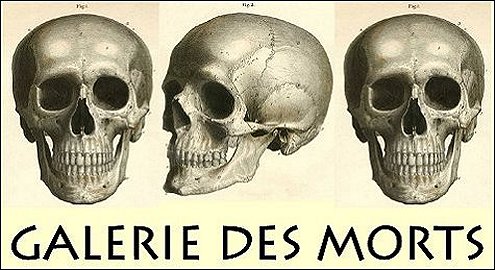
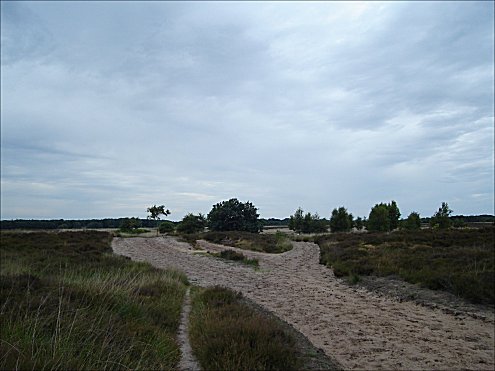
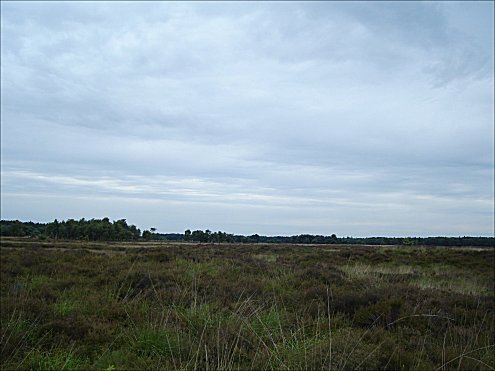
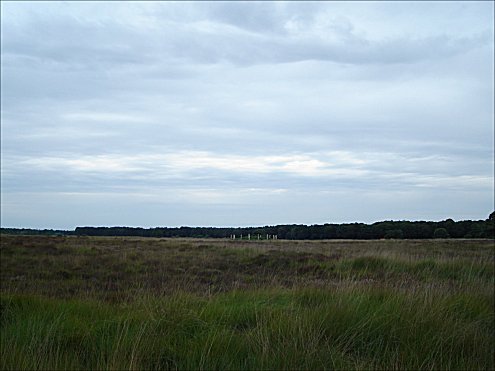
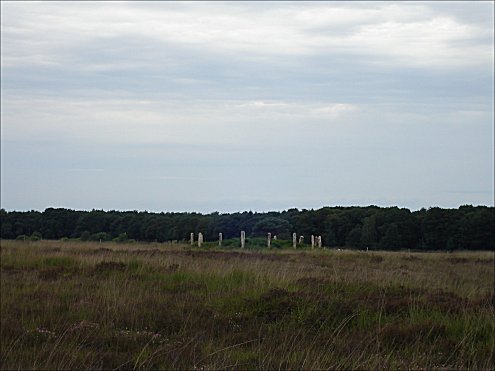
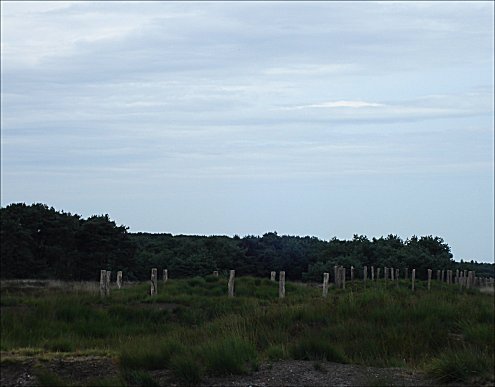
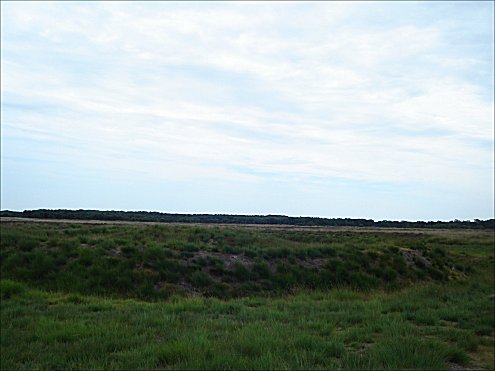
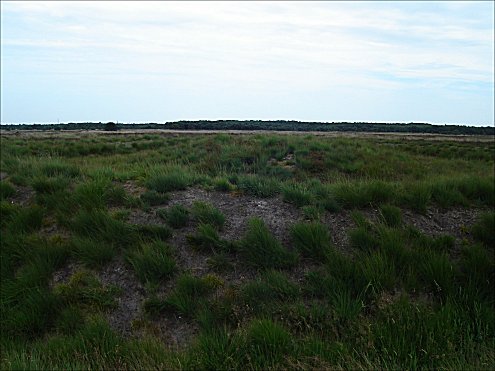
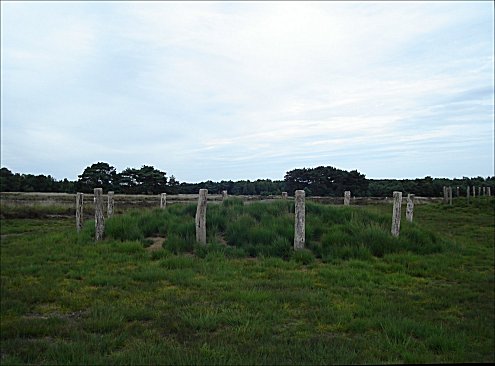
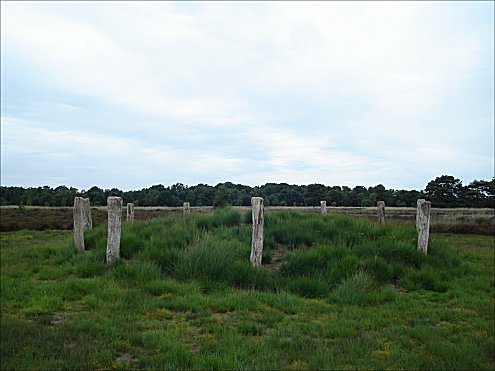
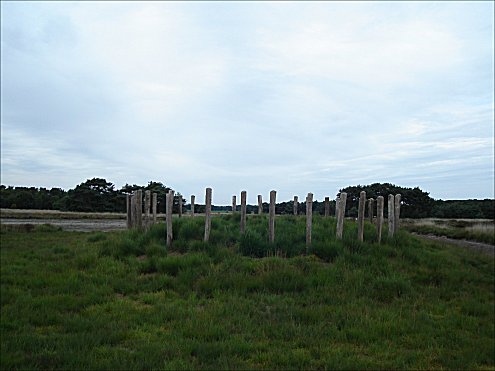
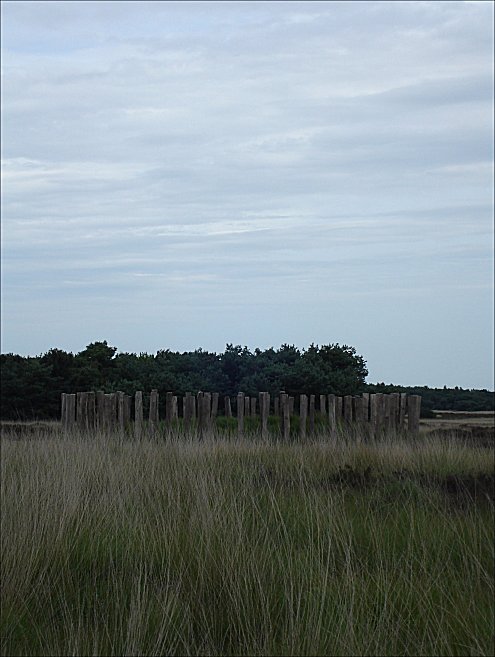

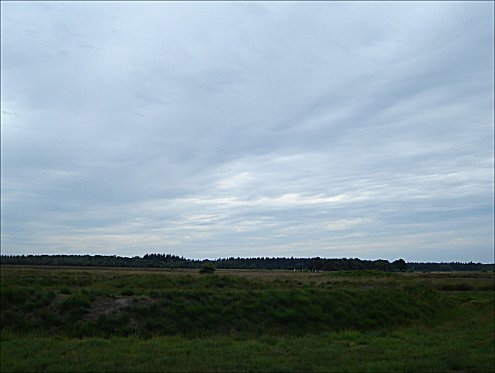

Galerie des Morts VIII
Tumulus Préhistorique
De Rechte Heide – Goirle NL
Photos: Kempis
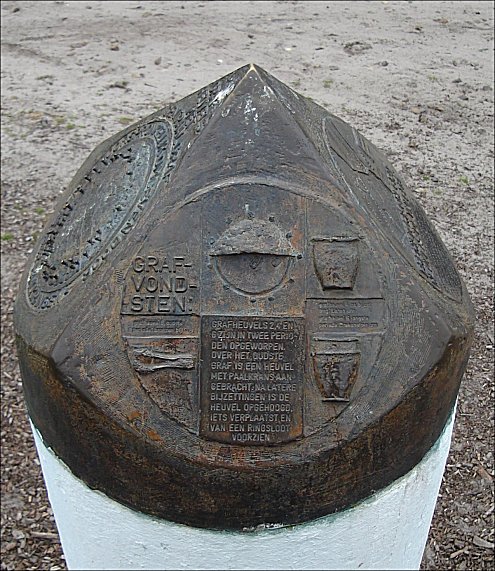
KEMP=MAG poetry magazine – magazine for art & literature
More in: Galerie des Morts


K21 DÜSSELDORF
Kunstsammlung Nordrhein-Westfalen
K21 features international art from 1980. With large and important works by Marcel Broodthaers und Nam June Paik, it sums up specific points of origin in the 60s and 70s. The first works of contemporary art were acquired during the foundation and opening phase of the new building. These essentially include photographic works by Andreas Gursky, Candida Höfer, Thomas Ruff, Thomas Struth and Jeff Wall, but also a video installation by Eija-Liisa Athila and a sculptural work by Thomas Schütte. In July 2004 the young museum was considerably enlarged, and in a tailor-made fashion, with the acquisition of the Ackermans collection by the region of North Rhine-Westphalia.
.jpg)
Having been assembled since the 80s, the collection now juxtaposes works which give outstanding visual form significant aspects of art since the beginnings of postmodernism. And in its concentration on sculpture and object art on the one hand, and photography on the other, the collection clearly demonstrates the close connection between German and international art during this period. There are well over 100 works, some of them in large formats. At the centre of the collection are works which show a reawakened interest in figuration, narrative, metaphor and a fascination with powerful images.
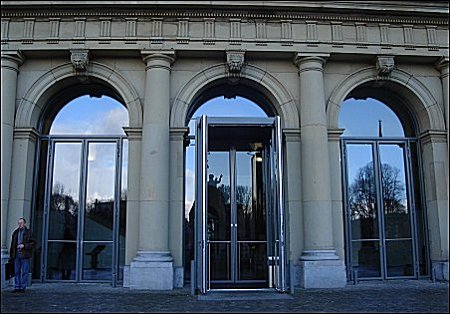
The cornerstones of the collection are artists like Katharina Fritsch, Robert Gober, Paul Mc Carthy, Reinhard Mucha, Thomas Ruff, Thomas Schütte, Jeff Wall and Franz West, each of whom are represented by several works or sets of works. Other outstanding works are by artists such as Christian Boltanski, Tony Cragg, Richard Deacon, Thomas Demand, Fischli & Weiss, Georg Herold, Thomas Hirschhorn, Ilya Kabakov, Juan Muñoz, Tony Oursler, Bill Viola and Rachel Whiteread. With a group of works from the sphere of Arte Povera (Jannis Kounellis, Mario Merz, Michelangelo Pistoletto) a connection is clearly established – as in the works by Broodthaers and Paik – with earlier artistic trends, and hence with the programme of K20.
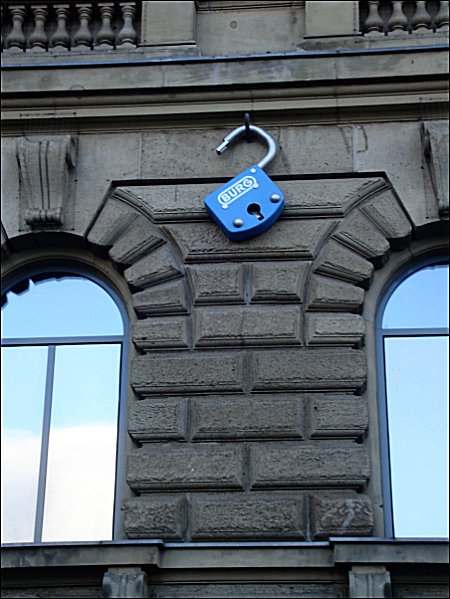
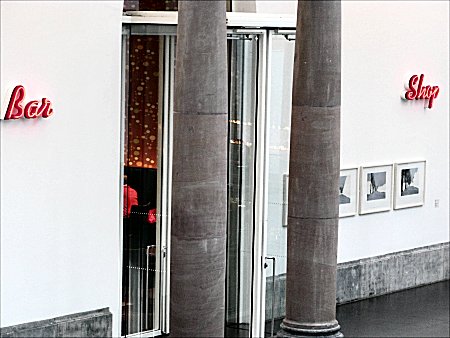
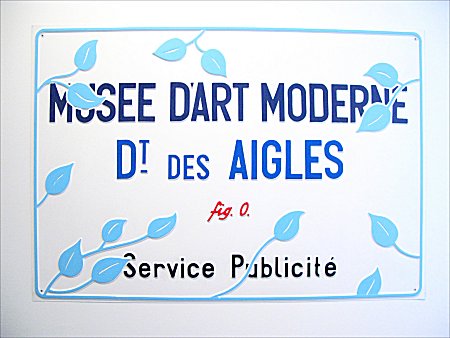
Marcel Broodthaers
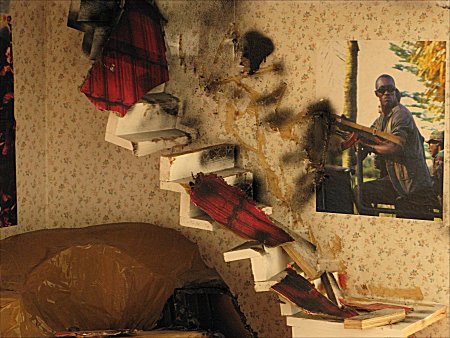
Thomas Hirschhorn
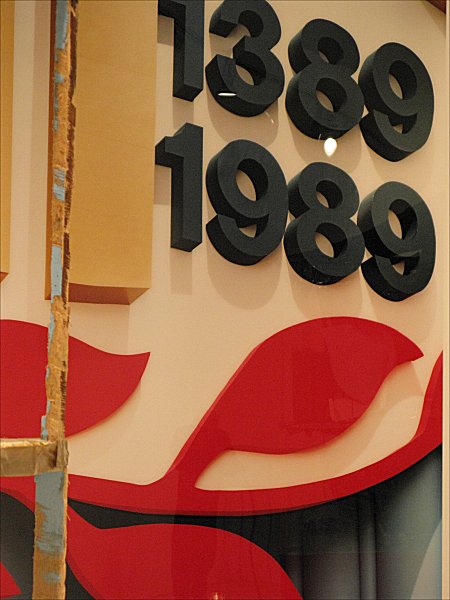
Thomas Demand
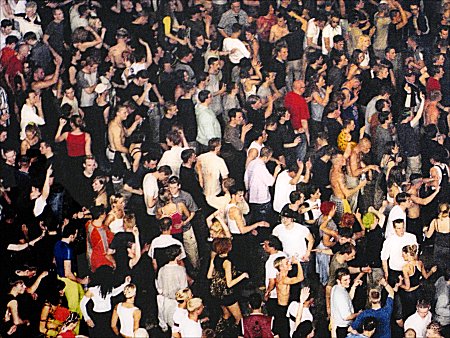
Andreas Gursky
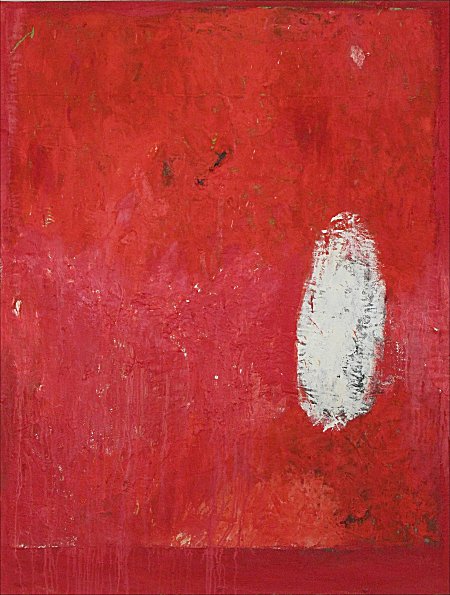
Franz West
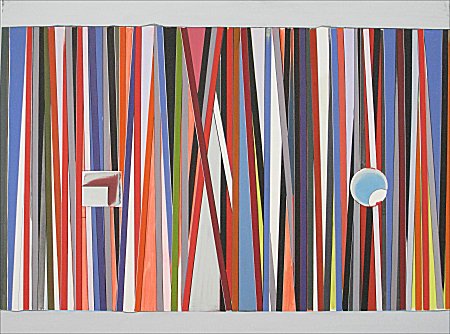
Thomas Scheibitz
K21 DÜSSELDORF
Kunstsammlung Nordrhein-Westfalen – part 1
photos Anton & Joseph K.
to be continued

KEMP=MAG poetry magazine
magazine for art & literature
More in: FDM Art Gallery
.jpg)
BBC POETRY SEASON
on TV, on radio and online
Spring 2009 sees the launch of
a landmark commitment to the arts
with a pan-BBC season dedicated to poetry
Some of the nation’s best loved poets and celebrities will take part in a season of big, bold content across television, radio and online; exploring the far-reaching, compelling and truly fascinating world of poetry.
Griff Rhys Jones launches the Poetry Season on BBC Two on 20 May at 9.00pm with a passionate plea about Why Poetry Matters – how verse has the power to move and why everybody needs it.
Also on BBC Two, My Life In Verse With… Robert Webb is the first in a four-part series exploring the rich terrain of poetry from Milton to Shakespeare through the eyes of four well-known personalities also including Sheila Hancock, Malorie Blackman and Cerys Mathews; and Off By Heart on Friday 22 May at 9.00pm follows primary school children across the country as they take part in a nationwide recitation competition, culminating in a grand final, compered by Jeremy Paxman.
T. S.BBC Four features an enlightening six-part series, A Poet’s Guide To Britain, presented by Owen Sheers, (Mondays, 8.30pm), which explores six great works about the British landscape; and Ian Hislop welcomes the new Poet Laureate in Ian Hislop Changing Of The Bard – featuring an entertaining history of one of the oldest and, he argues, oddest offices in the British establishment on 16 May at 10.00pm.
Also on BBC Four poet Simon Armitage goes in search of one of the jewels in the crown of British poetry, Sir Gawain, and historian Michael Wood returns to his first great love – the Anglo Saxon world – to reveal the origins of our literary heritage in Michael Wood On Beowulf.
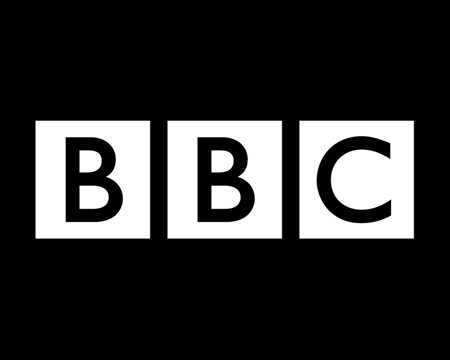 T. S.
T. S.
BBC Radio 3 and BBC Radio 4 will mark the 200th anniversary of the birth of Alfred Lord Tennyson, while The Essay – A Laureate’s Life, also on Radio 3, offers five personal takes on the role of Poet Laureate from around the world. Radio 4 will showcase its second Poetry Slam competition following on from its hit 2007 contest.
For younger viewers CBeebies cooks up a fresh, daily serving of scrummy Poetry Pie in a specially created new series for three to six year olds. Starting on BBC Two on May 18 poets from Brian Patten, Roger McGough and Children’s Laureate Michael Rosen to primary school pupils from across the UK contribute to a mix of funny and original rhythms and rhymes.
A dedicated website, bbc.co.uk/poetryseason, launching on 18 May, will feature a wealth of content including a vote to elect the Nation’s Favourite Poet, with short films from a host of celebrities making their case for their favourite poet including John Sergeant on Betjeman and Alex James on Auden. Plus the Poetry Season’s dedicated website will feature a poetry search engine to find poems according to a particular theme or mood.
George Entwistle, Controller Knowledge Commissioning, BBC Vision, says: “The Poetry Season offers viewers a fascinating and accessible insight into verse; there really is something for everyone.
“The UK has an extraordinary poetic tradition. We hope this season, the BBC’s fantastic accompanying online offering, and the other initiatives with the likes of the Poetry Society will inspire and motivate people to discover and reacquaint themselves with the poetry greats. In addition it may also inspire them to discover their own poetic voice.”
The BBC is working closely with external partners on the season including the Poetry Society and National Poetry Day.
BBC WEBSITE: bbc.co.uk/poetryseason
BBC Two
Why Poetry Matters, 20 May at 9.00pm (1×60)
Griff Rhys Jones launches the BBC’s Poetry Season with a passionate and personal plea about why poetry matters – how verse has the power to move, and why everybody needs it. Within this witty, stylish, high-impact hour, Griff makes the case that poetry is accessible, enjoyable and downright compelling.
Simon Schama’s John Donne (1×60)
Simon Schama celebrates the life and work of Britain’s greatest love poet, John Donne. For Schama, Donne is the poet who transformed English poetry through his use of language and emotional honesty. With the help of academic John Carey and actor Fiona Shaw, he undertakes a passionate appraisal and forensic examination of Donne’s work.
My Life In Verse With… (4×60)
From Burns to Milligan, Shakespeare to John Cooper-Clarke, many people, without even realising, have fragments of poetry lodged in their brains. Some of the nation’s best-loved celebrities, including Malorie Blackman, Sheila Hancock, Cerys Matthews and Robert Webb, take a journey of discovery into the poems that inspired them.
Off By Heart, 22 May 9.00pm (1×90)
Learning by heart is one of the best ways to experience a poem, but the method has fallen from favour as part of the educational system. To encourage primary school children to engage with poetry, BBC Learning has launched a new campaign, Off By Heart. Central to the BBC’s Poetry Season, this national recitation competition which launched on National Poetry Day in October 2008 continues in 2009 with BBC Two following children across the UK as they progress from regional heats to the grand final in Oxford, compered by Jeremy Paxman.
Armando Iannucci In Milton’s Heaven And Hell (1×60)
Milton is often considered too difficult, obscure or miserable for today’s reader, but to Iannucci, Paradise Lost is a thrilling work of creative genius that we ignore at our peril. Milton tackles everything from good and evil to human freedom and the existence of God, in language unparalled in scope and variety. In the film, Iannucci explores Paradise Lost in detail and looks at the way Milton’s extraordinary life, encompassing work as ‘spin doctor’ to Oliver Cromwell, being imprisoned in the Tower of London and losing his sight, all fed into his masterpiece.
Arena – T.S Eliot (1×60)
Arena contributes to BBC Two’s Poetry Season with a profile of T.S. Eliot which, with unprecedented co-operation from the Eliot Estate, tells the story of one of the 20th century’s most celebrated and elusive writers.
BBC Four
A Poet’s Guide To Britain, starts 4 May 8.30pm (6×30)
Poet and author Owen Sheers presents this series, in which he explores six great works of poetry about the British landscape. The poems by William Wordsworth, Matthew Arnold, Lynette Roberts, Sylvia Plath, Louis MacNeice and George Mackay Brown explore a sense of place and identity across Britain while also opening doors to stories about the lives of the poets themselves.
Ian Hislop’s Changing Of The Bard, 16 May 10.00pm (1×60)
One of the most unusual offices in the British establishment, the role of the Poet Laureate, has no official job description and a small salary which is traditionally supplemented by 650 bottles of the finest sherry. As Carol Ann Duffy, the newly appointed Laureate, settles into the job, Ian Hislop presents an informed and entertaining history of the post.
Sir Gawain And The Green Knight (1×60)
Poet Simon Armitage goes in search of one of the jewels in the crown of British poetry, Sir Gawain And The Green Knight. Following in the footsteps of the poem’s hero, Gawain, through some of Britain’s most beautiful and mystical landscapes, Simon discovers more about the poet, his world and the stories that inspired the poem.
Michael Wood On Beowulf (1×60)
Historian Michael Wood returns to his first great love – the Anglo Saxon world – to reveal the origins of our literary heritage. Focusing on Beowulf and drawing on other Anglo Saxon classics he traces the birth of English Poetry back to the Dark Ages. Travelling across the British Isles from East Anglia to Scotland and with the help of Nobel prize winning poet, Seamus Heaney, actor Julian Glover, local historians and enthusiasts he brings the story and language of this iconic poem to life.
The People’s Poetry – 30 years Of Poetry Please (1×30), 17 May at 9.30pm
Regularly attracting 1million listeners, the world’s longest-running poetry programme, Radio 4’s Poetry Please, reaches its 30th anniversary. BBC Four pays tribute to the programme in a half-hour film.
CBeebies
Poetry Pie starts 18 May on BBC Two
Straight from the oven, CBeebies cooks up a fresh, daily serving of scrummy poetry pie in a specially created new series for three to six year olds. Poets from Brian Patten, Roger McGough and Children’s Laureate Michael Rosen to primary school pupils from across the UK contribute to a mix of funny and original rhythms and rhymes. Each episode is a unique recipe for poetic fun with every poem animated and brought vividly to life by one of five characters who act, dance and sing the words to the poems.
Radio 3
Sonnet Day, May 20
Radio 3 marks the 400th anniversary of the publication of Shakespeare’s sonnets on 20 May with 14 sonnets read by leading actors throughout the day.
Poems For Today
Starting on May 21, Radio 3 celebrates contemporary poetry with a series of more than 40 poems, broadcast daily over a six-week period, celebrating the breadth of contemporary poetry in the UK today. Each of the poems will have been written or published within the last 12 months and will reflect the range of diverse voices that exist in the UK.
Sunday Feature – Children Of The Whitsun Weddings, May 24
Poets Kate Clanchy and Paul Farley take a train through “Larkinland”, as they explore their mutual admiration for Philip Larkin’s work. Born within days of each other in 1965, nine months after the publication of Larkin’s The Whitsun Weddings, Kate and Paul have very different poetic voices. They travel across Britain retracing some of Larkin’s key journeys from Oxford to Hull and Leeds to London, leading the two to a series of lively interchanges on the poet’s influence on them and on their shared passion for Larkin’s work.
Drama On 3 – Idylls Of The King
Radio 3 broadcasts a new adaptation by award-winning poet Michael Symmonds Roberts of Tennyson’s epic poem telling the story of King Arthur.
Sunday Feature – Searching For Alfred: In The Shadow Of Tennyson
Poet Ruth Padel, herself inspired by Tennyson, seeks out the real Alfred and asks why he has become such a lofty remote figure. Two hundred years after his birth Ruth investigates his legacy in art, film and music of all kinds and reveals that Tennyson is a poet for our times as well as his own.
The Essay – Tennyson 200
Marking the 200th anniversary of the birth of one of Britain’s greatest poets, four contemporary British poets each choose a single poem or extract by Tennyson and give a personal account of why it means so much to them.
This content is in addition to Radio 3’s ongoing speech output – Between The Ears, Night Waves, Sunday Feature, The Essay and The Verb, all of which prominently feature poetry.
Radio 4
Radio 4 will broadcast a series of programmes on Tennyson including an edition of Poetry Please featuring readings of his poetry and Great Lives which will explore Lord Tennyson’s life and its impact.
The series of programmes will also include a dramatisation of Tennyson’s poem Maud, while Ulysses Revisited, presented by Sean O’Brien, will explore in detail Tennyson’s great poem, Ulysses.
Poetry Slam 2009
Radio 4 will be broadcasting its second Poetry Slam in early autumn 2009, bringing together some of the best and most popular spoken word performers from all around the country to battle it out for the title of Radio 4 Slam Winner 2009.
![]()
Events and online
BBC Learning is supporting the season with a host of events and online activity from May through to National Poetry Day in October.
These include:
An online vote to determine the Nation’s Favourite Poet. Compiled with the Poetry Society and The Arts Council, a shortlist of 30 of Britain’s finest poets will feature on the Poetry Season website. Gems from the BBC archive and examples of their work will help visitors to the site discover more about the shortlisted candidates. A host of celebrities will make the case for their favourite poets via a collection of short films, including John Sergeant on Betjeman, Alex James on Auden, Michelle Ryan on Rudyard Kipling and Nihal on William Blake.
A dedicated Poetry Season website, bbc.co.uk/poetryseason, launching 18 May which will serve as the destination for anyone wanting to learn more about poets and their work. Key features of the site include a poetry search engine enabling users to discover poems based on themes and moods; short films with contemporary poets featuring suggestions on how to enjoy poetry; and links to BBC Poetry Season content.
A must-watch viral campaign introducing some of the nation’s great poems and poets to young audiences and demonstrating their power in a modern context. A host of viral videos will be released throughout the season to show how poetry is a powerful and relevant form of expression.
Live events around the UK run by The Poetry Society, Apples and Snakes, Radio 4 and BBC Blast.
![]()
FLEURSDUMAL.NL MAGAZINE
More in: Armitage, Simon, Art & Literature News, AUDIO, CINEMA, RADIO & TV, Eliot, T. S., FDM in London
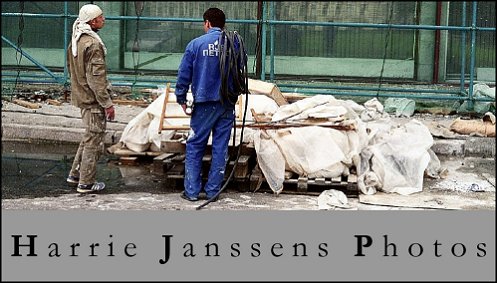
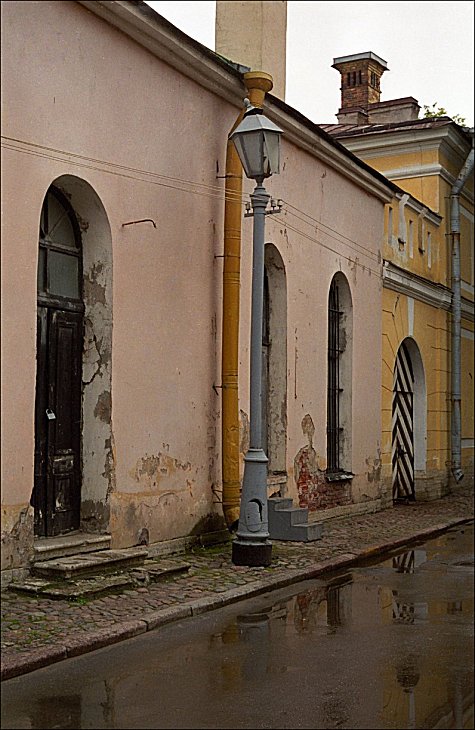
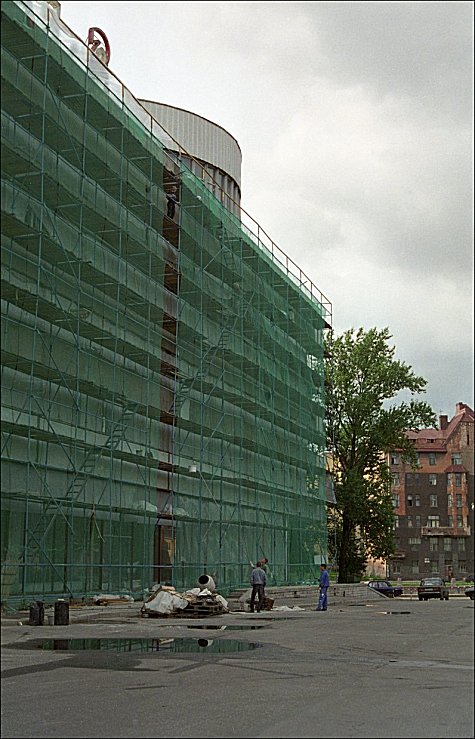
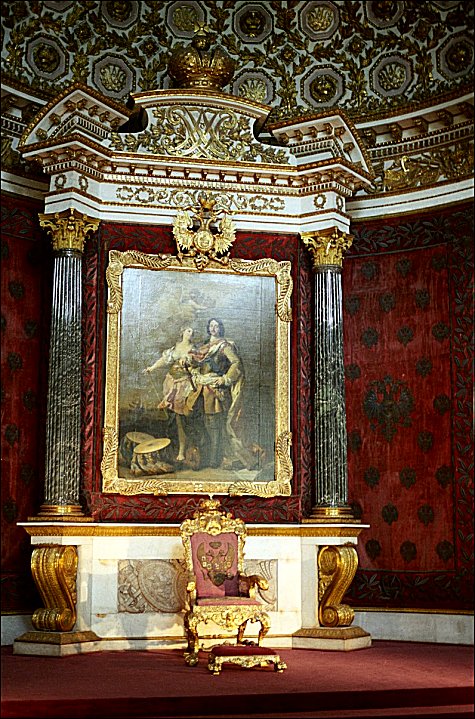
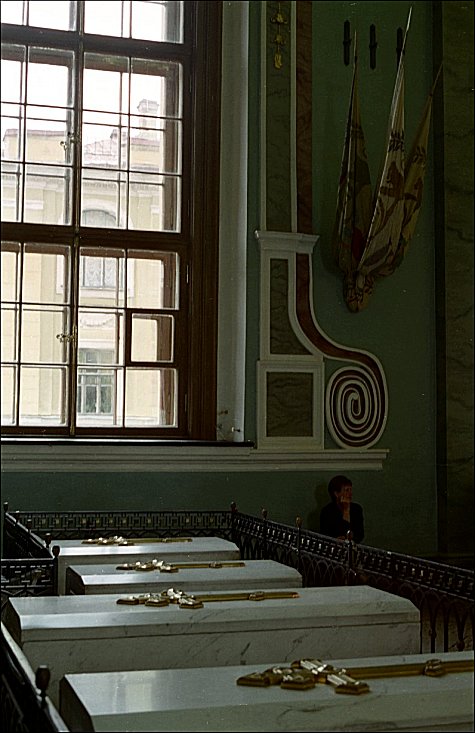

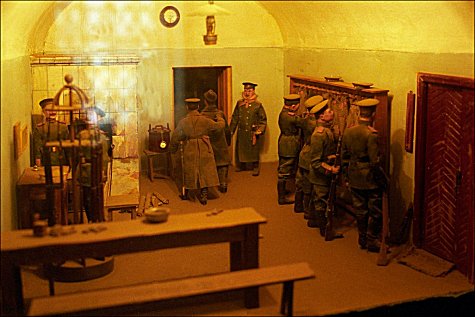

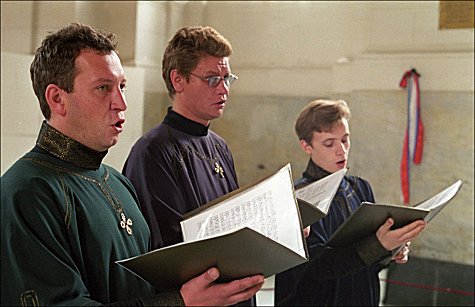
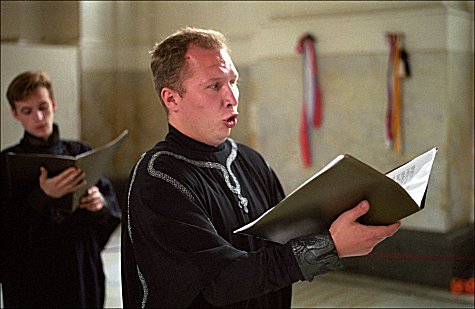
Harrie Janssens photos:
St. Petersburg – Russia – part 1
KEMP=MAG POETRY MAGAZINE – MAGAZINE FOR ART & LITERATURE
© H. Janssens 2000
More in: Harrie Janssens Photos
W I E L S – B R U S S E L
L u c T u y m a n s
AGAINST THE DAY
23 April – 02 August 2009

This first solo show of Luc Tuymans in Brussels presents, in world premiere, twenty new paintings which he created especially for Wiels.
This is the first solo exhibition of Luc Tuymans in Brussels. The artist will present, in world premiere, twenty new paintings. The works are the third and last part of a triptych that began with the series Les Revenants about the power of the Jesuit Order and continued with Forever. The Management of Magic, about the Walt Disney phenomenon.
In this new series, Tuymans continues his work focusing on virtual reality, fantasies and illusions in images and concentrates on virtual images and images without any sense of reality. Thus, Tuymans continues his research on the illusion and manipulation of images and gives answers through his painting practice. Most or practically all of Tuymans’ paintings are based upon already represented imagery, ranging from drawings, photographs, found images, film-stills, Polaroid’s, etc. He calls his work ‘authentic forgeries’, convinced that original images do not exist and that every image is derived from another. He uses family pictures and historical images as representations of social-political taboos and a traumatic past.
The function of the close-up, the framing and other visual principles, which the artistsappropriated from cinema, is remarkable. Tuymans used to make films and the storyboard – like drawings such as Lift (1980) demonstrate his cinematographic point of view. In Blacklight (1994), a chair, a sofa, a standard lamp and a television set are crowded in the right corner of the images, as if we are looking in through a swerving camera. The framing suggests a snapshot of a passing movement and enlarges the sense of impending doom. The image is never fragmented. The image is fragmentary as a whole. It finds itself somewhere between spectator and image, in a claustrophobic place of non-communication, as an accomplished fact, as the silent weight of deceit, memory and trauma before or after an event.
Through mimicry, the artist realises a reconstruction. The imagery permits different interpretations and several layers of meaning, therefore it can only be perceived as ambiguous and dubious.
Tuymans is one of the most respected painters of his generation. His work is largely included in prominent international museums, e.g. the Museum Of Modern Art in New York and the National Museum of Modern Art Georges Pompidou Centre Paris. He participated in important exhibitions such as Documenta IX 1992. He had a solo exhibition in 2002 in Helsinki. In 2004, Tate Modern London (UK) scheduled a great solo show of his paintings.
This exhibition travelled to the K21 Kunstsammlung Düsseldorf (GER). He participated in the Biennale di Sao Paulo del Brasile in 2004. Several major solo exhibitions were planned in 2007, including a retrospective at Haus der Kunst, München (D) and a show at Zeno X Gallery, Antwerp (BE). In 2008, Forever. The Management of Magic was organized at David Zwirner, New York, NY. In 2009, the exhibition Against The Day will be held at Wiels which will travel to Rooseum-Moderna Museet in Stockholm (SV). In 2010, several American museums have invited Tuymans to have a large solo exhibition at their institutes.
Luc Tuymans commentary “Against the Day”
“I adopted the title Against the Day from a book by Thomas Pynchon (2006). Thomas Pynchon is my favourite American author and one of the inventors of paranoia in American literature.”
There is an anonymization of the painting (Ed. The Game Warden, Fernand Khnopff, 1883, coll. Stâdelmuseum Frankfurt a/M) which fascinated me to such an extent that I linked one of my own most recent paintings to it: Against the Day. My painting was probably painted against an entirely different ideational background – but then again there are affinities. And not simply because there is also a tree. My tree, of course, is the one in my little city garden behind my own house. Once I furnished a colleague with a cap, a blue jacket and a shovel with which he shovelled the soil. He was completely engrossed in this work. His facial features can no longer be recognized. One has an inkling of his face, one senses it, but it is ultimately not important
whether one figures out who it is or what this person is feeling. This person is part of the hermetic scene – as in the Khnopff. Here the time of day is defined. It is a nocturne. It is a painting not so very much concerned with nature. It is a painting that actually takes place off in a corner, facing the viewer, showing the act of shovelling. In the foreground, the overexposed, colourful image of a tree appears, depicting a kind of blur. The latter contrasts with the unbelievably elaborate development of the rest of the depiction. This painting also has something to do with a fascination, an aspect which, in turn relates back to the conceivable cynicism of a man like Fernand Khnopff, who was a member of society’s upper class and could therefore naturally take various liberties. The French, and above all the French authors and intellectuals, considered Fernand Khnopff the only truly important Belgian artist aside from Félicien Rops. Something that naturally flattered both of them. Khnopff’s favourite time of the year – as he always said – was the autumn.
The painting Against the Day will serve as the title motif for an exhibition by the same name, which I’m planning for next year (scheduled to open on 23 April 2009 at the Kunsthalle Wiels in Brussels). I adopted the title Against the Day from a book by Thomas Pynchon (2006). Thomas Pynchon is my favourite American author and one of the inventors of paranoia in American literature. But there is also something else to which the painting makes reference: to the book Oil by Upton Sinclair, which was adapted to the screen in 2007 by Paul Thomas Anderson: There Will Be Blood. The film pursues the idea of minimalism, a certain banality. More specifically,banality in the sense of reality – regardless of how the latter is actually shaped, whether it is triggered artificially, through scenography, or not.
For me, already in reaction to my previous exhibitions, a certain idea developed – and this is precisely what interests me about Khnopff: the evacuation of the utopia. The evacuation of the utopia took place gradually over time and through history – actually like a form of pornography though one which associated itself with a person on a mental level. The evacuation of the utopia goes above and beyond the banality of this painting, which is a domesticated painting because it is concerned with a specific territory such as, for example, the pictorial field. For me, a further thought develops toward the idea of a virtual reality, in which already now one constructs people in their entirety and then plays them back into a scene. Usually the latter is a computer image and it is no longer clear whether the figure is real or not. This image has been created with a perfection of the kind applied so many centuries ago by Van Eyck, now, however, with a machine. This is how the Big Brother reality shows and horror broadcasts work, which – with the aid of the forensic sciences – are robbed of the whole utopia through reassembly, reconstruction.
Luc Tuymans in : “Reconsidered”, Selected Works from the Städel Collection, Städel Museum, Frankfurt a/M, 2008, p. 50-51.
fleursdumal.nl– magazine for art & literature
More in: Exhibition Archive
G r o n i n g e r M u s e u m
14 maart t/m 31 mei 2009
D a n i e l l e K w a a i t a a l
Whispering Waters
![]()
Van 14 maart tot en met 31 mei 2009 presenteert het Groninger Museum in de ‘Groene Zaal’ nieuw werk van kunstenaar Danielle Kwaaitaal (Bussum, 1964). Whispering Waters (2009) bestaat uit een serie onderwaterfoto’s die Kwaaitaal maakte in samenwerking met modeontwerpster Mada van Gaans.
In het werk van Danielle Kwaaitaal speelt de betekenis van het vrouw zijn een belangrijke rol. Zij is gefascineerd door ‘het schoonheidsideaal’ in menselijke maar ook in artistieke zin. In haar nieuwe werk zoekt zij aansluiting met de wereld van de mode om ‘schoonheid’ als maatschappelijk vraagstuk voor het voetlicht te brengen. Mode beïnvloedt de manier waarop vrouwen naar zichzelf en naar anderen kijken. In Whispering Waters gaat de vrouw op zoek naar haar identiteit en vindt zij zichzelf terug in een donkere, geïsoleerde wereld. Kwaaitaal lijkt hiermee te willen zeggen dat de huidige dictatuur van de mode en de schoonheidsindustrie niet bijdraagt aan de opbouw van het ik, maar juist aan de vernietiging ervan. De bespiegeling over het vrouw zijn is ook in deze werken duidelijk aanwezig, maar door de sculpturaliteit en het verdwijnen van het zichtbare ‘ik’ slaat Kwaaitaal met Whispering Waters een nieuwe weg in.
Kwaaitaal’s fascinatie voor water en vrouwelijke vormen kwam voor het eerst tot uiting in de serie Bubbling uit 1994. Bubbling, die ook onderdeel uitmaakt van deze tentoonstelling, toont lichaamsdelen die onderwater zijn gedompeld en die in samenspel met de vele luchtbelletjes wonderlijke en raadselachtige beelden opleveren. In serie Whispering Waters verlaat Kwaaitaal deze abstrahering van het menselijke lichaam en gaat zij opzoek naar krachtige vormen en vrouwelijke identiteit, wat resulteert in scènes uit een beklemmende wereld die bevolkt wordt door nimfachtige wezens.
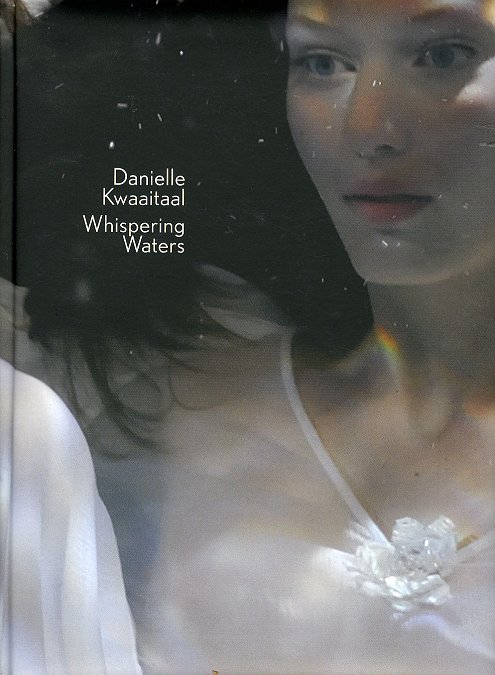
Speciaal voor deze tentoonstelling heeft Danielle Kwaaitaal modeontwerpster Mada van Gaans gevraagd een aantal ‘onderwaterjurken’ te ontwerpen. ‘Haar virtuoze gebruik van stoffen en haar uitzonderlijke kleurgevoel sluiten naadloos aan bij het opgeroepen beeld, waarin harde contouren en zijdezachte kleurovergangen hand in hand gaan’, aldus Kwaaitaal. De jurken werden gedragen door cat-walk modellen en zwemsters van synchroon- zwemvereniging ZPCH uit Hoofddorp, die voor de gelegenheid optraden als onderwater- modellen en die daarvoor een speciale choreografie uitvoerden.
Kwaaitaal is een van de pioniers van de digitaal gemanipuleerde fotografie. De serie Bodyscapes (1992) creëerde zij met behulp van de paintboxcomputer, waarmee zij beelden van lichaamsdelen samensmolt tot ‘lichaamslandschappen’. Na het met dezelfde techniek gemaakte Bubbling volgden andere series, zoals Airheads: onderwater-portretfoto’s van figuren uit de Amsterdamse clubscene. In 1994 richtte Kwaaitaal Techno Creations op, één van de eerste VJ collectieven, waarmee zij haar werk bij een ander en jonger publiek onder de aandacht bracht. Met het onderwatersprookje FLO (2004) bracht zij een ode aan het vrouwelijke lichaam met een sensuele Ellen ten Damme in de hoofdrol.
Kwaaitaal maakte ook werken in de openbare ruimte. Voor het stadsdeelkantoor in Bos en Lommer maakte zij grote fotowanden waarin Marokkaanse en Nederlandse landschappen in elkaar overvloeien. Voor de luchthaven Schiphol creëerde zij Tracing Reality (2008) een serie fotografische panorama’s achter de douane in de B/C corridor.
Tijdens de tentoonstelling verschijnt de uitgave Whispering Waters.
40 pagina’s, 20 full-color afbeeldingen- Hardcover, 17 x 23 cm, staand
Voorwoord: Pietje Tegenbosch – Uitgever d’jonge Hond. www.dejongehond.nl
ISBN: 978 90 89101 211 – Prijs: € 18,95
fleursdumal.nl magazine – magazine for art & literature
More in: Art & Literature News, FDM Art Gallery
Thank you for reading Fleurs du Mal - magazine for art & literature